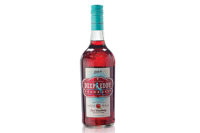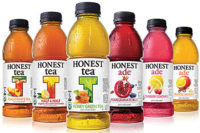Labels help packaging grab attention

When Alice fell down the rabbit hole, she probably didn’t stop to ponder what kind of labeling material was on that bottle reading “Drink Me.” If only it were so simple for beverage manufacturers to get customers to do the same with a simple label and easy-to-follow directions.
Today’s beverage labels are the workhorses of beverage marketing, catching consumers’ eyes, drawing them in and enticing them to pick the beverage off the shelf. With so much riding on a beverage product’s label, it’s no surprise that innovation in beverage labeling materials is an important point of focus for many manufacturers these days.
“Labeling remains the brand’s most effective way to communicate and connect with the consumer,” says Doug Wegman, director of marketing and strategic planning for Hammer Packaging, Rochester, N.Y. “However, more and more we see the container taking on more form and function to capture the consumer’s attention at the point-of-sale. The ability to create a label that conforms to the shape of the container as well as provide 360-degree graphics has fueled this trend.”
A new looking-glass
To keep on top of trends and ahead of the curve, new materials regularly are being rolled out.
“Synthetic materials for cut and stack labels, which are now available in clear and metalized as well as white, provide an upscale look, durability and moisture resistance,” says Gwen Chapdelaine, marketing director for Fort Dearborn Co., Elk Grove, Ill. “Clear film substrates are also available for pressure-sensitive products for a more natural and upscale look. And for shrink sleeve labels, high-yield PETG film provides an upscale matte finish that offers higher opacity and light blocking capabilities.”
Chapdelaine adds that developments in barrier sleeves also are providing products with more opportunities for shelf-life extension and lighter weight containers.
Metalized papers create a luxury look, says Kathy Popovich, director of marketing for Hamilton, Ohio-based Innovative Labeling Solutions. “[Label] designs range from very simple to really showcase the silver, to ornate graphics that incorporate ink opacities to deliver shimmer and reflection throughout the design.”
Popovich also cites the conversion of more beverage labels to shrink sleeve as allowing for a more dynamic presentation on the shelf.
“Argo Tea, a tea café with stores in Chicago, New York and St. Louis recently launched a ready-to-drink line of teas they make fresh to order in the café,” Popovich explains. “The curvy glass bottles are adorned with a modern-looking shrink sleeve design, each with a different flavor pattern.”
Shrink sleeves on beverage containers have grown during the last few years and continue to expand. Don Earl, president of Long Island, N.Y.-based Overnight Labels Inc., notes that the development of a shrink sleeve line material on a continuous roll is making its way into the labeling material arena.
“It’s cut in line and the seam gets glued in line, and it shrinks to the bottle, so there’s a lot less converting to it,” he says.
During the past year, multiple companies have introduced new technologies to improve their labeling materials. Hammer Packaging’s Wegman cites the rollout of roll-applied shrink (RAS) film and surface-printed shrink sleeves and roll-fed labels.
“The RAS film provides the user with a material that has a higher yield and a lower film weight,” Wegman explains. “Surface printing allows the user to use a mono-web structure and eliminate the lamination layer.” Both innovations create an environmentally advantageous product, he adds.
Jim Dwyer, president and chief executive officer of Anaheim, Calif.-based R.B. Dwyer Group noted the incorporation of the company’s Infinitely Variable Cylinder Web Offset (IVCO) print technology from RPD Marathon that produces high-quality graphics at a low cost.
“The IVCO press allows for an extended gamut of colors without the expense of spot colors,” Dwyer says.
At Fort Dearborn Co., the latest advancements include fluorescent, glow-in-the-dark and thermochromatic inks, and coatings such as acid etch, frosted, pearlescent, holographic and matte.
“To add functionality to labels we add scratch and sniff inks, soft-touch coatings and high-yield PETG shrink films,” Chapdelaine says.
Earth-friendly materials
Being eco-friendly and sustainable in labeling is very important to beverage manufacturers these days.
“We’re seeing a growing focus in the area of sustainability,” Wegman says. “Hammer has been active with our vendor partners to provide customers with a number of environmentally responsible solutions.”
For example, Hammer Packaging offers a 30 percent post-consumer waste paper, a 10 percent post-consumer wet-strength paper and electronic beam inks that are non-solvent based and use 50 percent less energy for curing.
Innovative Labeling Solutions’ Popovich also sees manufacturers asking for labeling materials with a green edge.
“[There has been] a consistent request for more sustainable substrates, those that are FSC-certified, recyclable or made with post-consumer waste,” she says. “The major material suppliers continue to develop their portfolios, which greatly benefits the entire supply chain. But the major objection to this point has been price parity, as consumers want to choose the more environmentally friendly item.”
R.B. Dwyer Group’s newest press also has sustainable benefits, Dwyer says.
“Our IVCO uses UV inks, which reduce the carbon footprint,” he says. “It offers a more sustainable footprint, and both the customer and the retailer benefit from the state-of-the-art equipment.”
Cost reduction
When it comes to labeling materials, one thing remains the same: cost reduction.
“Companies are always looking for cost reduction opportunities, especially in a tough economic climate,” Chapdelaine says.
To help their customers save, she suggests investigating substrate and print method alternatives, and supply chain management programs that leverage technology to reduce costs. Additionally, finding “technical resources to help identify efficiency improvement efforts within a customer’s facility” also has aided in keeping labeling costs down in rough economic times.
“When the economy goes bad we expect to see two opposing trends,” Wegman says. “Brands that pull in their marketing and look for ways to lower costs, and brands that look to exploit the moment to boost their brand by refreshing their message and graphics. Today’s economy is no different, and if anything, I’d say we’re seeing more of the latter: a greater attempt by brands to reconnect with their market through a change in label type or design.”
Besides changing and refreshing looks, keeping tabs on the materials you have also is important in a rocky economy.
“The economy has forced companies to re-evaluate their procurement protocol, as well as better manage inventory obsolescence,” Popovich says. “We’ve seen a shift in blanket orders that typically cover a two- to three-month stock position, to one that is more print-to-demand or just-in-time delivery.”
However, Popovich continues, “With HP Indigo press technology, which is where we see major growth for our organization, the added benefit of no plates allows for late stage differentiation as well as maximized graphic flexibility for changes and additions to existing SKUs, as well as adding new ones to product lines.”
Lighting the way
Shelf impact, functionality and sustainability: manufacturers agree that these three points are key for labeling materials to better keep products on an upward and innovative path.
“Everyone is looking for the ‘wow’ factor for their product,” says R.B. Dwyer Group’s Dwyer. “Standing out on the shelf will always make beverage labeling competitive. We’re looking forward to newer films in our product offering.”
Requests for environmentally friendly labels are forecast to grow, Hammer Packaging’s Wegman says.
“Beverage labeling will continue to become more environmentally friendly as newer materials are introduced to the market,” he says. “They will also be strongly influenced by package designs that are evolving as brands adapt to the evolving needs of social-conscious consumers and retailers.”
Wegman adds that labeling featuring 2-D barcodes could build intimacy and dialogue with a growing base of tech-savvy consumers, while digital printing remains “on the periphery waiting to become more mainstream as large-volume printing costs come down.”
Innovative Labeling Solutions’ Popovich adds that digital imaging was slow to take hold, “but now with the introduction of the latest generation of presses, this is changing. Digital is allowing consumer packaged goods to market in whole new ways.” BI
Related Links:
Packaging: Sustainability prevails as the top trend for beverage packaging
Packaging: 360-degrees of graphics grab attention
Looking for a reprint of this article?
From high-res PDFs to custom plaques, order your copy today!





